
A strategy game or strategic game is a game in which the players' uncoerced, and often autonomous, decision-making skills have a high significance in determining the outcome. Almost all strategy games require internal decision tree-style thinking, and typically very high situational awareness.
Warlords is a video game series created by Steve Fawkner, in which role-playing elements are combined with turn-based strategy in a fantasy setting. The series includes four games and two expansion packs. Several remakes exist.

Memoir '44 is a light wargame, or war-themed strategy board game, for two players created by Richard Borg, published in 2004 by Days of Wonder and illustrated by Julien Delval and Cyrille Daujean. The game can also be played with up to six players if played in teams and up to eight players in the "Overlord" scenarios that require two copies of the game. It received the 2004 International Gamers Award for General Strategy, 2-Player category and The Wargamer 2004 Award for Excellence. The game is published in English and French by Days of Wonder.
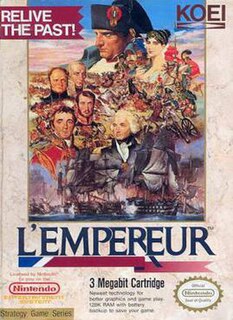
L'Empereur is a turn-based strategy video game for the Nintendo Entertainment System released by the Koei company in 1989.

Pacific General is a computer wargame depicting famous battles of the World War II Pacific campaigns. It was published by Strategic Simulations in 1997 using the same game engine of the earlier and successful Panzer General for Windows 95. It was re-released on GOG.com in May 2015.

Dragon Force is a real-time strategy and tactical role-playing game from Sega created for the Sega Saturn. It was created in Japan and translated for North American release by Working Designs in 1996, a translation that was also used by Sega in Europe under license from Working Designs. The game's main selling point was that battles involve up to 200 soldiers fighting on screen in real time, causing them to be often likened to the battle scenes in the then-recent film Braveheart.

Bandit Kings of Ancient China, also known as Suikoden: Tenmei no Chikai in Japan, is a turn-based strategy video game developed and published by Koei, and released in 1989 for MSX, MS-DOS, Amiga, and Macintosh and in 1990 for the Nintendo Entertainment System. In 1996, Koei issued a remake for the Japanese Sega Saturn and PlayStation featuring vastly improved graphics and new arrangements of the original songs.
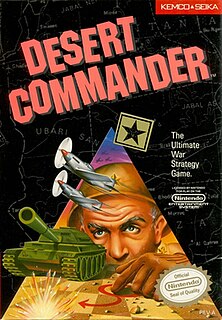
Desert Commander is a 1988 turn-based strategy video game developed and published by Kemco in Japan and North America for the Nintendo Entertainment System. It is themed after the North African theatre of World War II in the 1940s, where players take command of the Allied Forces led by George S. Patton and Bernard Montgomery to fight against the Axis Powers led by Erwin Rommel. Its gameplay consists of moving units into positions to confront enemies in turn-based encounters determined by multiple factors, replenishing units with resources in order to occupy the enemy headquarters or destroy all enemy forces. The title garnered positive reception from critics; Reviewers praised several aspects such as the presentation, visuals, controls, challenge and balance of strategy and action, though others criticized certain design choices while fan reception proved to be mixed in Japan.
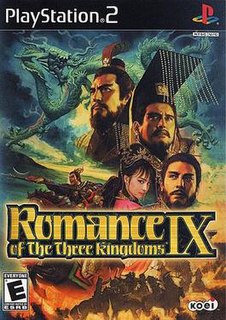
Romance of the Three Kingdoms IX, also known as Sangokushi IX (三國志IX) in Japan, is the ninth installment in the Romance of the Three Kingdoms (Sangokushi) strategy game series by Koei. The game chronicles the events of 2nd and 3rd century China based on the writings of the historical novel Romance of the Three Kingdoms. Players are able to play through various historical, challenge, or "if" scenarios with the automatic rank of ruler.

Genghis Khan, original full title Aoki Ōkami to Shiroki Mejika: Genghis Khan (蒼き狼と白き牝鹿・ジンギスカン), is a 1987 turn-based strategy game developed by Koei, originally released for the NEC PC-9801, MSX and Sharp X68000 in 1988, the DOS and NES in 1990, and the Amiga in 1990. It is actually the second game in the series, after a 1985 Aoki Ōkami to Shiroki Mejika, also for PC-88, PC-98, and MSX.
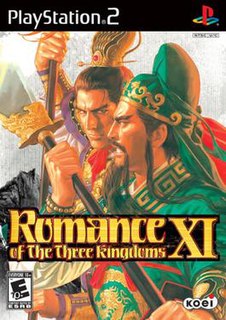
Romance of the Three Kingdoms XI, also known as Sangokushi 11 (三國志11), is the 11th installment in the Romance of the Three Kingdoms (Sangokushi) grand strategy game series by Koei. The game was released for the PC on March 17, 2006 in Japan. A Traditional Chinese version was released on July 27 in Taiwan.

Inindo: Way of the Ninja is a role-playing video game developed and published by Koei. Originally released for the PC8801SR, PC9801, MSX2 home computer and X68000, it was remade for the Super NES, which was also released in North America. The game is a fictional account of Japan's warring states period.

In military tactics, a flanking maneuver is a movement of an armed force around an enemy force's side, or flank, to achieve an advantageous position over it. Flanking is useful because a force's fighting strength is typically concentrated in its front, therefore, to circumvent an opposing force's front and attack its flank is to concentrate one's own offense in the area where the enemy is least able to concentrate defense.

Dynasty Warriors is a game in the Dynasty Warriors series for the PlayStation Portable, created by the game development company Koei. This game was released as a launch title in Japan on December 16, 2004 and as a launch title on March 16, 2005 in North America, and September 1, 2005 in Europe. The sequel to this game is Dynasty Warriors Vol. 2.

Bladestorm: The Hundred Years' War is a historical real-time tactics video game for the PlayStation 3 and Xbox 360 platforms. It was published by Koei and developed by Omega Force. An enhanced expansion remake, entitled Bladestorm: Nightmare was released for PlayStation 3, PlayStation 4, and Xbox One in Japan on January 29, 2015, and a couple of months later in the rest of the world. The worldwide Microsoft Windows release was on May 29, 2015. The game is loosely based on the Hundred Years' War between the Kingdoms of England and France in the 14th and 15th centuries. Just like the Kessen and Musou series from Koei, certain liberties are taken from the original history. For example, unlike what happened in real life, it is possible to save Joan of Arc from being burned at the stake. The Nightmare edition features creatures like dragons and goblins in an alternate storyline.
Dynasty Tactics is a strategy game for the Sony PlayStation 2. The title is set during the Three Kingdoms era and takes place after the Yellow Turban Rebellion and Dong Zhuo's death. The gameplay uses elements from Koei's in depth turn based system in the Romance of the Three Kingdoms series. While the Dynasty Warriors series is a contemporary interpretation of the setting, the mood in Dynasty Tactics is archaic and gritty, closer to the tone set in the novel. The players can choose to roughly follow events from the epic or dramatically diverge from it.

P.T.O., released as Teitoku no Ketsudan (提督の決断) in Japan, is a console strategy video game released by Koei. It was originally released for the PC-9801 in 1989 and had been ported to various platforms, such as the X68000, FM Towns, PC-8801 (1990), MSX2 (1991), Sega Genesis and the Super NES. Players could assume one side of the Pacific Theater of Operations during World War II, acting as naval commander, organizing fleets, building new ships, appropriating supplies and fuel, and even engaging in diplomacy with other countries. The player can choose one of several World War Two battles to simulate, or could control the entire Pacific campaign well before the Japanese attack on Pearl Harbor.
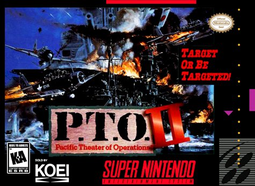
P.T.O. II, released as Teitoku no Ketsudan II (提督の決断II) in Japan, is a Koei strategy video game that depicts the conflict between the US and Japan during World War II. The video game is a sequel to P.T.O. It was originally released in 1993 for the NEC PC-9801 and had been ported to various platforms since, such as the Super Nintendo Entertainment System.

Nobunaga's Ambition is a 1986 strategy game by Koei, focused in the Sengoku period of the history of Japan. A part of Koei's "Historical Simulation" line of titles, it was published on several platforms such as IBM PC compatibles, Amiga, the Nintendo Entertainment System, Super NES, and Mega-Drive. It is the second game in the Nobunaga's Ambition series and the first Nobunaga's Ambition title to be released in English. The player has the objective unifying Japan as Oda Nobunaga or as any of the other daimyos present in the game. Several revisions were made to the gameplay since the first game, as well as a 50-province mode which expanded the game's map to feature all of Japan.
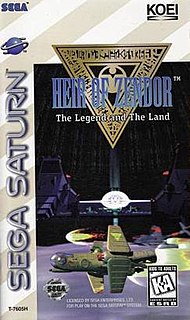
Heir of Zendor: The Legend and The Land, released in Japan as Gotha II, is a strategy video game developed by Micronet and published by Koei. It is the sequel to Gotha: Ismailia Seneki. It was an exclusive for the Sega Saturn in North America, while in Japan it also appeared on the PlayStation.

















